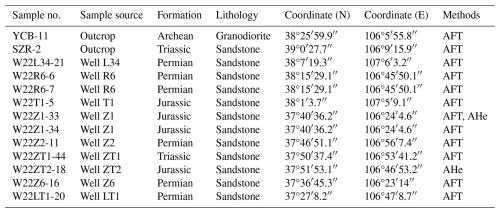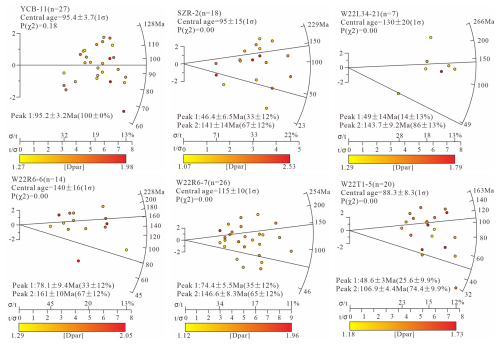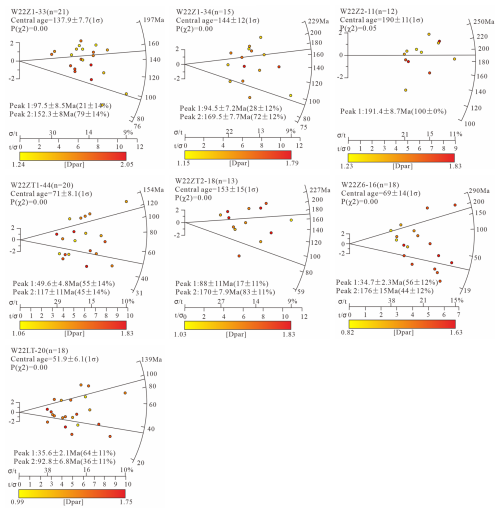the Creative Commons Attribution 4.0 License.
the Creative Commons Attribution 4.0 License.
Low-temperature thermochronology and its geological significance in the central-northern section of the western margin of the Ordos Basin
Guangyuan Xing
Zhanli Ren
Sasa Guo
Yanzhao Liu
Ying Zhang
Huaping Lan
The study of low-temperature thermochronology at plate edges provides favourable constraints for regional tectonic evolution and surface processes. Based on the existing thermochronological data of multiple cooling events since the Mesozoic era, we conducted apatite fission-track and (U–Th) He dating studies on drilling samples from the central-northern section of the western margin of the Ordos Basin, revealing the exhumation and cooling history, including differences, in the study area. The new thermal-history inverse modelling results show that the Zhuozishan Mountain region (ZM region) experienced large-scale exhumation in the Late Jurassic (160–150 Ma), with an average exhumation rate of ca. 45 m Ma−1 and an average cooling rate of ca. 2 °C Ma−1; slow exhumation in the Early Cretaceous–Oligocene (130–30 Ma), with an average exhumation rate of ca. 10 m Ma−1 and an average cooling rate of ca. 1 °C Ma−1; and severe exhumation after the Oligocene (30 Ma–present), with an average exhumation rate of ca. 30 m Ma−1 and an average cooling rate of ca. 1.2 °C Ma−1. The Taole–Hengshanbao region (TH region) started exhumation in the Late Jurassic–Early Cretaceous (155–145 Ma), with an average exhumation rate of ca. 48 m Ma−1 and an average cooling rate of ca. 2.4 °C Ma−1; underwent slow exhumation in the Early Cretaceous–Oligocene (145–30 Ma), with an average exhumation rate of ca. 7.5 m Ma−1 and an average cooling rate of ca. 0.3 °C Ma−1; and then underwent violently exhumation, with an average exhumation rate of ca. 25 m Ma−1 and an average cooling rate of ca. 1 °C Ma−1. The Majiatan–Huianbao region (MH region) experienced large-scale exhumation in the Late Jurassic–Early Cretaceous (158–137 Ma), with an average exhumation rate of ca. 45 m Ma−1 and an average cooling rate of ca. 1.8 °C Ma−1; featured a slightly slower exhumation rate at 137–110 Ma, with an average exhumation rate of ca. 13 m Ma−1 and an average cooling rate of ca. 0.52 °C Ma−1; and entered a severe exhumation stage again in the Late Cretaceous–Eocene (70–50 Ma), with an average exhumation rate of ca. 37.5 m Ma−1 and an average cooling rate of ca. 1.5 °C Ma−1. The Late Jurassic tectonic exhumation indicated by thermochronology corresponds to the formation of the western-margin fold-and-thrust belt, with the northern and southern sections starting earlier and the central section starting slightly later. At the same time, the exhumation time of different fault blocks decreased gradually from the edge of the basin towards the centre, following an E–W direction. This is related to the different tectonic evolution and stress patterns in the different locations.
- Article
(8841 KB) - Full-text XML
- BibTeX
- EndNote
The North China Craton, as one of the oldest cratons in the world, has a long history spanning 3.8 billion years (Zhai, 2010; Zhang et al., 2018). Having undergone prolonged and complex tectonic evolution, it records nearly all major tectonic events, especially preserving multi-phase evolutionary remnants since 1.8 Ga (Peng et al., 2022). In this context, the Ordos Block, located in the western part of the North China Craton and representing one of its core geological units, has developed since the Mesozoic as a residual intracratonic basin (Bao et al., 2019; Zhai, 2021; Ren, 1995; Zhai, 2021; Liu et al., 2005). The Ordos Basin preserves the most complete sedimentary strata in the North China Craton, covering Proterozoic, Palaeozoic, Mesozoic, and Cenozoic sedimentary strata on the Archean crystalline basement, and is rich in various energy and mineral resources such as oil, gas, coal, and uranium deposits. The thrust belt along the western margin of the Ordos Basin is situated at the junction of several geologically distinct blocks, including the North China Craton, the Alxa Block, the Central Asian Orogenic Belt, the Qinling Orogenic Belt, and the northeastern margin of the Tibetan Plateau (Fig. 1). This region has experienced some of the most intense tectonic deformation on the Chinese mainland since the Mesozoic, preserving a complex record of intracontinental deformation and multiple orogenic events.
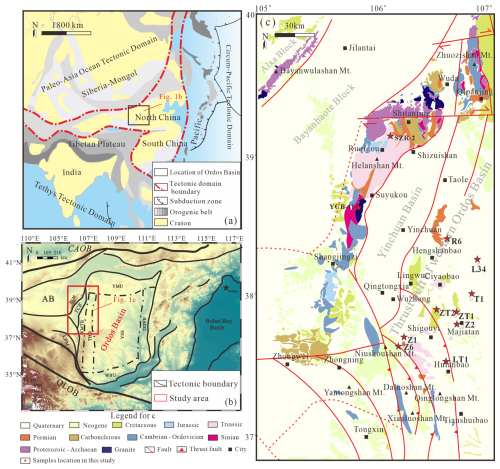
Figure 1(a) Tectonic setting of China (modified from Peng et al., 2019). (b) Digital elevation model of the Ordos Basin and surrounding areas. The red rectangle is the research area of this article (modified from Qi et al., 2024). Abbreviations: AB, Alxa Block; CAOB, Central Asian Orogenic Belt; HLM, Helanshan Mountain; JXFFB, Jinxi Fault–Fold Belt; LPM, Liupan Mountain; QLOB, Qinling Orogenic Belt; THD, Tianhuan Depression; WMTB, Western Margin Thrust Belt; WBU, Weibei Uplift; YCB, Yinchuan Basin; YMU, Yimeng Uplift; YSS, Yishan Slope. (c) Geological map of the central-northern section of the western margin of the Ordos Basin (modified from Ma, 2019) and the sample locations in this study.
The study area is located in the central-northern section of the western margin of the Ordos Basin (Fig. 1). Influenced by multiple tectonic movements, the region has a complex evolutionary history, with several large-scale faults. In general, it can be asserted that the structural style of the western margin of the Ordos Basin is the result of the interaction between adjacent blocks. Over the years, previously published papers have investigated the structural characteristics and properties of the western margin of the Ordos Basin (Yang and Zhang, 1986; Tang et al., 1988; Tang, 1992; Gan, 1990; Liu, 1995; Zhao et al., 1990), its formation mechanisms (Liu and Yang, 1997; Liu et al., 2005; Ouyang et al., 2012; H. Yang et al., 2011; S. B. Yang et al., 2006, 2008; Zhao, 2003; Zhao et al., 2006, 2007a, b, c), and its provenance (Jiang et al., 2019). Regarding the overall exhumation process along the western margin of the Ordos Basin, previously published papers based on the apatite fission-track method suggest that the exhumation in the southern section of the western margin of the Ordos Basin began in the Middle–Late Jurassic (Chen, 1999; Chen et al., 2007; Gao et al., 2000; Zhang et al., 2000; Zhao et al., 2006, 2007a, c; Zhao, 2017; Li, 2019; Ma and He, 2019; Peng, 2020; Tian et al., 2023). In the study area, thermochronological studies are relatively scarce and have mainly focused on the Helanshan Mountain area (Ma and He, 2019; Zhao et al., 2007a; Liu, 2010), the Zhuozishan Mountain region (Zhuo, 2015; Li Bin, 2006), the Shigouyi area (Gao, 2014; Zhao et al., 2007b, c; Ma and He, 2019; Li, 2019), and drilling wells such as LC1, T1, and TS1 (Ren, 1995) (Fig. 2).
On the basis of the published thermochronological data (Ma and He, 2019; Zhao et al., 2007a, b; Liu, 2010; Zhuo, 2015; Li, 2019; Gao, 2014; Ren, 1995), the study area recorded an exhumation event during the Mesozoic, but the timings and rates of this event vary across different regions. The structural differences between the basin margin and the inner part have not been well clarified. Current research lacks a comprehensive perspective and does not provide a systematic understanding of tectonic events in the central-northern section of the western margin of the Ordos Basin since the Mesozoic. This greatly limits further insights into the overall tectonic evolution of the area and poses significant challenges for deeper research into intracontinental deformation in the basin and its surrounding regions.
This study applied low-temperature thermochronology methods, combined with thermal-history modelling and field observation, to precisely constrain the exhumation and cooling history of the central-northern section of the western margin of the Ordos Basin. The research helps to improve our understanding of the tectonic evolution and processes in this region since the Mesozoic. Additionally, it offers a foundational reference for future oil and gas exploration efforts in the western margin of the basin.
The Ordos Basin, as one of the key geological elements of the North China Craton, is a large basin that formed during different periods and geodynamic settings (Ren et al., 2020). The evolution of the basin can be divided into several stages: Archean–Palaeoproterozoic basement formation, Mesoproterozoic–Neoproterozoic rift basin development, early Palaeozoic stable continental margin sedimentation, late Palaeozoic to Middle Triassic intracratonic basin evolution, Late Triassic to Jurassic intracontinental depression basin evolution, Early Cretaceous westward contraction of the basin, Late Cretaceous to Cenozoic basin exhumation, and formation of Cenozoic fault-depression basins in the surrounding areas (Liu et al., 2005; Ren et al., 2020; Li, 2006).
In order to define more precisely the differences in exhumation and cooling stages since the Mesozoic era, this article further divides the research area into the Zhuozishan Mountain (ZM) region, the Taole–Hengshanbao (TH) region, and the Majiatan–Huianbao (MH) region.
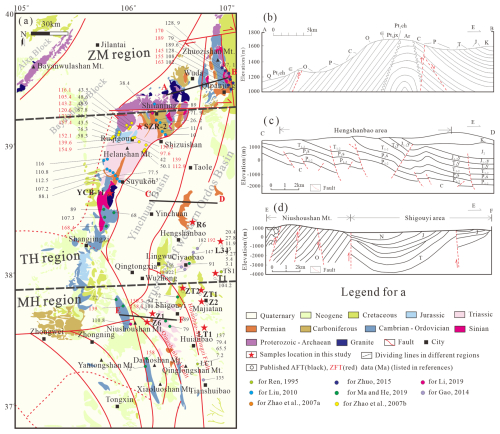
Figure 2(a) Compilation of previously published low-temperature thermochronological data in the study area, (b–d) W–E-oriented simplified geological cross-sections (modified from Xing et al., 2024; Liu et al., 2024; and Ma and He, 2019, respectively). Q – Quaternary, N – Neogene, K – Cretaceous, J – Jurassic, T – Triassic, P – Permian, C – Carboniferous, O – Ordovician, ∈ – Cambrian, Pt2ch – Changcheng System, Pt2jx – Jixian system, Ar – Archean.
In the ZM region, the main body is characterized by the presence of the Zhuonzishan anticline, which has an E–W length of about 20 km, showing the Archean granitic gneiss of the Qianlishan Group at its core. Moving westwards, it sequentially exposes the Changcheng System, Jixian System, Cambrian strata, Ordovician strata, and Permian strata and exposes the Carboniferous, Permian, Triassic, Jurassic, and Cretaceous strata in sequence towards the east (Fig. 2b) (Zhuo, 2015; Xing et al., 2024). In the TH region, the strata are deformed by N–S-trending thrust faults, forming a typical imbricate thrust system (Fig. 2c). In the MH region, four west-dipping thrust faults develop from west to east. Among them, the Shigouyi fault zone, in a syncline form, is situated between the Qingshanlong Fault and the Huianbao–Shajingzi Fault (Fig. 2d).
3.1 Previous thermochronological data
This study collected a total of 85 published low-temperature thermochronology data points from the western margin of the Ordos Basin, specifically from the area between Zhuozishan Mountain and the city of Tianshuibao, comprising 62 apatite fission-track ages and 23 zircon fission-track ages (Fig. 3). Samples with higher mineral closure temperatures exhibit older apparent ages. The ages obtained through the apatite fission-track analysis range from 189.6 to 3.1 Ma, while zircon fission-track ages range from 192 to 105.4 Ma. These findings indicate a long cooling history and a complex exhumation process in the study area. Based on the collected data, we plotted histograms and kernel density estimation curves, revealing that the density peaks for apatite and zircon are at 78 and 101 Ma and at 153 Ma, respectively (Fig. 3).
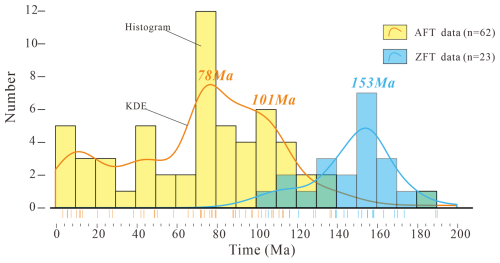
Figure 3Histogram and kernel density estimation (KDE) plot of published thermochronological data in the study area.
In summary, previous thermochronological data indicate that multiple cooling events have occurred in the region since the Mesozoic era (Ren, 1995; Zhao et al., 2007a, b; Liu, 2010; Zhuo, 2015; Gao, 2014; Li, 2019; Ma and He, 2019). Due to the lack of thermochronological techniques such as the (U–Th) He method and the existence of regional differences in the study area, the cooling history of the study area after the Mesozoic has not been systematically constrained.
3.2 Sample collection and experimental methods
This study applies low-temperature thermochronological methods to constrain the spatiotemporal evolution of the upper few kilometres of the lithosphere. Apatite fission-track analysis is sensitive to temperature variations in the range of 60 to 120 °C (the partial annealing zone), while apatite (U–Th) He dating is suitable for defining the time–temperature history in the range of 40 to 75 °C (Ketcham, 2005; Gallagher, 2012; Flowers et al., 2015; Farley et al., 1996).
Previous thermochronological studies in the ZM region are documented in Xing et al. (2024). To address the current gaps in thermochronology in the study area and to analyse the differences in exhumation and cooling at the edge of the Ordos Basin towards the depocentre, we collected 13 samples that were well distributed across the TH and MH regions (Fig. 2a), including 11 core samples from 9 drilling wells and 2 field outcrop samples. Sample locations and information are reported in Fig. 2a and Table 1, respectively.
3.2.1 AFT data
After obtaining the samples, apatite was separated using conventional heavy-liquid and magnetic separation methods. The samples were prepared and analysed at the Petroleum Thermochronology Laboratory in the Department of Geology at Northwest University. The calculation method for AFT ages follows Hasebe et al. (2004), and ages were analysed using RadialPlotter software (Vermeesch, 2009). Additionally, HeFTy software (version 1.6.7) was used for inverse modelling to reconstruct the cooling history (Ketcham, 2005).
Based on the test results, the exhumation rate of this area can be calculated. The calculation formula is
Here, U represents the exhumation rate (the exhumation rate of apatite since it entered the annealing zone), measured in m Ma−1; θ is the closure temperature of the mineral, in °C; K is the geothermal gradient, in °C (100 m)−1; T0 is the mean annual surface temperature, in degrees Celsius (°C); and F represents the fission-track age, in millions of years (Ma). For the sake of discussion and comparison, this paper adopts the same parameters as Zhao et al. (2007c), with K set at 4 °C (100 m)−1, T0 at 25 °C, and θ at 110 °C.
3.2.2 AHe data
Following three criteria – crystalline integrity of the automorphic particles, the purity of the particles, and ensuring that the crystal dimensions perpendicular to the c axis exceed 60–70 µm – apatite grains from samples Z1-33 and ZT2-18 were chosen under a high-magnification (160×) binocular microscope for (U–Th) He (AHe) dating. The dating was conducted at the Ar–Ar and (U–Th) He Geochronology Laboratory of the Institute of Geology and Geophysics, Chinese Academy of Sciences.
3.2.3 Thermal modelling
Due to the complexity of annealing processes, the measured apparent ages lack any practical geological significance (Flowers et al., 2015). By utilizing the measured ages, track lengths, angles with the c axis of mineral particles, and Dpar values, this thermal history can be inversely modelled (Ketcham, 2005). The multi-dynamic annealing model proposed by Ketcham (2005) was used for the inversion simulation, along with the corrected confined track lengths. The original confined track length was set at 16.3 µm, and the present-day surface temperature was 20 °C. The goodness-of-fit (GOF) parameter was used to indicate how well the simulation results matched the actual measurements. In particular, when the GOF value obtained from the simulation exceeds 0.05, the simulation results are acceptable, while a GOF value greater than 0.5 indicates a very good match. The simulated ages and lengths both had GOF values greater than 0.5 and close to 1, suggesting that the simulation results closely aligned with the measured values.
4.1 Low-temperature thermochronology results
4.1.1 The TH region
The AFT central ages of the two samples from well R6 (R6-6 and R6-7) are 140.4 ± 15.7 and 115.3 ± 10.2 Ma, with average track lengths of 11.66 ± 1.02 and 12.1 ± 1.52 µm, respectively. The AFT central age of the sample from well L34 (L34-21) is 130 ± 19.8 Ma. In the Helanshan Mountain area, the AFT central ages of samples SZR-2 and YCB-11 are 95.2 ± 14.8 and 95.4 ± 3.7 Ma, with average track lengths of 12.01 ± 1.68 and 12.88 ± 1.11 µm, respectively. In this region, the AFT central ages of these five samples are significantly younger than the stratigraphic ages, indicating that the samples have undergone annealing and cooling processes. Only the YCB-11 sample passed the χ2 test, with a single peak age of 95.2 ± 3.2 Ma. For the other samples, we obtained at least two peak ages, recording potential tectonic activities from the Late Jurassic to Eocene (Table 2, Fig. 4).
Table 2Fission-track results of the TH and MH regions.
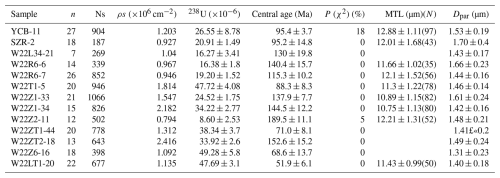
n: number of measured grains; Ns: the track numbers measured; ρs: spontaneous track densities; P: probability of obtaining a χ2-test value – a probability > 5 % is indicative of a homogenous population; MTL: mean confined track length with c-axis correction.
4.1.2 The MH region
As this area is a key region for oil and gas exploration, a large number of drilling samples are available. Except for sample Z2-11, the remaining samples did not pass the χ2 test. The fission-track ages obtained for this region range from 189.5 to 35.6 Ma and were statistically divided into three peak values: 42, 95, and 170 Ma (Fig. 5). All of these ages are significantly younger than the stratigraphic ages, indicating that they have undergone exhumation and cooling processes. The three single-grain AHe ages for sample Z1-33 range from 61.64 to 67.06 Ma, while the three single-grain AHe ages for sample ZT2-18 range from 50.69 to 56.31 Ma, with no significant correlation to the effective uranium (eU), recording late exhumation and cooling events (Table 3, Fig. 6).
Table 3(U–Th) He data of apatite grains belonging to boreholes Z1 and ZT2 (MH region).

Rs: equivalent spherical radius; [eU]: effective uranium concentration; FT: α-ejection correction factor; Cor. age: AHe age with α-ejection correction.
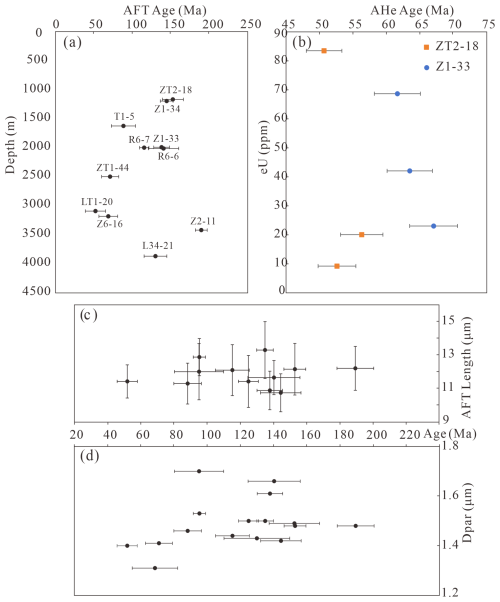
Figure 6Correlation between (a) AFT ages and depth, (b) AHe ages and eU, (c) AFT ages and lengths, and (d) AFT ages and Dpar.
In addition, the correlation between track length and AFT age indicates a complex cooling history in the region. Considering the different annealing dynamics (Ketcham et al., 2007), the chemical composition of the grains may influence the AFT age and length (Carlson et al., 1999; Barbarand et al., 2003). However, the Dpar values in the samples range from 1.31 to 1.70 µm, showing minimal variation and no significant correlation with the AFT ages. This suggests that the influence of chemical composition on AFT age is either minimal or nonexistent.
4.2 Thermal-history modelling
Among the 13 samples, 9 that have a broad distribution within the study area and longer length values were selected for the thermal inverse modelling. The GOF parameters for both length and age in this simulation were above 0.90, indicating a good fit. The inverted time–temperature paths are shown in Fig. 7.
The modelling results indicate significant differences in the thermal histories of samples from different regions. Two samples from the western part of the TH region record a rapid exhumation event from 110 to 90 Ma, followed by a long period of slow cooling and finally a rapid cooling event around 25 Ma. In the MH region, the samples record a rapid exhumation event from 158 to 137 Ma and rapid exhumation between 70 and 50 Ma. The specific simulation results are shown in Fig. 7.
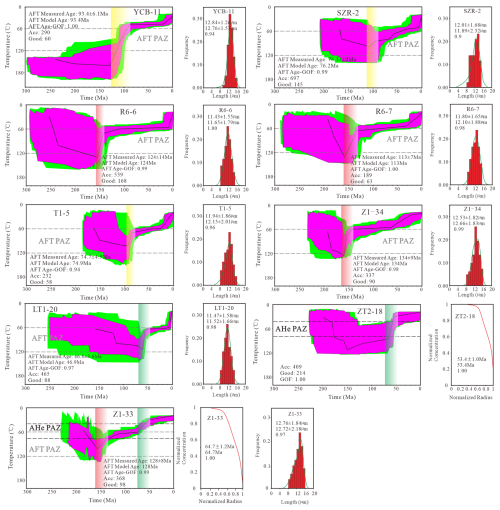
Figure 7Thermal-history inverse modelling calculated by HeFTy (Ketcham, 2005), using the annealing model of Ketcham et al. (2007) and the calibration approach of Flowers et al. (2009). HeFTy modelling tests possible t–T curves using the Monte Carlo search method. Shaded parts of different colours represent different cooling periods.
From the thermal-history modelling paths, the exhumation initiation times generally fall in the Late Jurassic; however, there are still differences (Fig. 8). This is related to the tectonic evolution and stress at the respective locations. Therefore, the exhumation intensity varies from east to west across the regions.
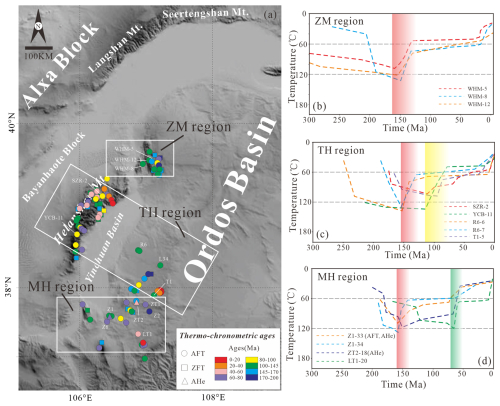
Figure 8(a) Summary of all available thermochronology data. The data sources are the same as in Fig. 2. (b–d) The thermal-history paths summarized in this study from the ZM region, TH region, and MH region, respectively.
5.1 Exhumation process differences and geological responses in the central-northern section of the western margin of the Ordos Basin constrained by low-temperature thermochronology
5.1.1 The ZM region
The region has undergone three major exhumation stages since the Mesozoic: the first phase was the Late Jurassic (160–150 Ma), marking the first major exhumation stage in the area, with an average exhumation rate of ca. 45 m Ma−1 and an average cooling rate of ca. 2 °C Ma−1. This exhumation corresponds to the early stages of the Yanshanian orogeny in the region, as evidenced by the modelling results of all three samples. The second phase was one of slow cooling, with an average exhumation rate of ca. 10 m Ma−1 and an average cooling rate of ca. 1 °C Ma−1 in the Early Cretaceous–Oligocene (130–30 Ma), suggesting the absence of significant tectonic events during this time. The timing and exhumation differences among the samples during this phase may reflect the varying effects of different episodes of the Yanshanian orogeny on the region. The most recent exhumation stage is associated with the Himalayan orogeny, which caused further significant exhumation in the region, with an average exhumation rate of ca. 30 m Ma−1 and an average cooling rate of ca. 1.2 °C Ma−1 in the Cenozoic (since ca. 30 Ma).
5.1.2 The TH region
In the Taole–Hengshanbao area, two samples from well R6 have peak ages of 161, 146, 78, and 74 Ma, suggesting possible tectonic events during the Late Jurassic and Late Cretaceous. The inverse thermal models of both samples show similar results, indicating three phases of exhumation: a period of significant exhumation with an average exhumation rate of ca. 48 m Ma−1 and an average cooling rate of ca. 2.4 °C Ma−1 in the Late Jurassic (155–145 Ma); a period of slow cooling with an average exhumation rate of ca. 7.5 m Ma−1 and an average cooling rate of ca. 0.3 °C Ma−1 in the Early Cretaceous–Oligocene (145–30 Ma); and a recent exhumation stage with an average exhumation rate of ca. 25 m Ma−1 and an average cooling rate of ca. 1 °C Ma−1 in the Cenozoic (ca. 30 Ma–present). The ages recorded in samples R6-6 and R6-7 are basically the same. The slight differences in their AFT model results arise because R6-6 was located deeper, meaning it exited the partial annealing zone later than R6-7 during exhumation. This caused the AFT age constraints for R6-6 to be slightly younger. For the T1-5 sample, located in the THD, exhumation began at the end of the Early Cretaceous, with an average exhumation rate of ca. 50 m Ma−1 and an average cooling rate of ca. 2 °C Ma−1. This area previously had a complete sedimentary sequence and extensive sediment distribution, forming the thick Tianhuan syncline in the Ordos Basin (Zhao et al., 2007a).
The exhumation in this area is related to the exhumation in the neighbouring Helanshan Mountain region and the intense faulting and subsidence in the Yinchuan Graben. The thermal-history models of the two Helanshan Mountain samples (SZR-2 and YCB-11) also have a certain pattern in spatial and temporal distribution: the YCB-11 sample in the south entered a rapid cooling stage from the end of the Early Cretaceous to the Late Cretaceous (130–95 Ma), with an average exhumation rate of ca. 46 m Ma−1 and an average cooling rate of ca. 1.8 °C Ma−1, followed by slow cooling with an average exhumation rate of ca. 2.5 m Ma−1 until the Eocene (∼ 35 Ma), after which it underwent rapid exhumation to the surface, with an average exhumation rate of ca. 18 m Ma−1 and an average cooling rate of ca. 0.7 °C Ma−1. The northern SZR-2 sample, however, shows a delayed cooling history at essentially the same rate of exhumation, with cooling events occurring primarily after the Early Cretaceous. The exhumation pattern, with earlier exhumation in the south and later exhumation in the north, aligns with previous studies on the Helanshan Mountain region (Ma and He, 2019).
5.1.3 The MH region
In the southern Majiatan–Huianbao area, two samples from well Z1 (Z1-33 and Z1-34) indicate that exhumation in the well began during the Late Jurassic (ca. 160 Ma). Combined AFT and AHe inverse thermal modelling shows that sample Z1-33 experienced rapid exhumation between 158 and 137 Ma, with an average exhumation rate of ca. 45 m Ma−1 and an average cooling rate of ca. 1.8 °C Ma−1, followed by slower exhumation from 137 to 110 Ma, with an average exhumation rate of ca. 13 m Ma−1 and an average cooling rate of ca. 0.52 °C Ma−1, and then it entered another phase of intense exhumation between 70 and 50 Ma, with an average exhumation rate of ca. 37.5 m Ma−1 and an average cooling rate of ca. 1.5 °C Ma−1. Sample Z1-34, constrained only by AFT data, shows large-scale exhumation starting from 160 to 140 Ma, a slow exhumation phase from 140 to 64 Ma, and then a rapid exhumation event. Since the temperature at 64 Ma is beyond the AFT-sensitive temperature range, the thermal-history model of well Z1, especially for the later stages of exhumation and cooling, is more reliably constrained by the dual-dating sample Z1-33. The AFT simulation of sample LT1-20 reveals an exhumation event between 60 and 55 Ma, with an average exhumation rate of ca. 60 m Ma−1 and an average cooling rate of ca. 4 °C Ma−1, and the AHe thermal-history simulation of sample ZT2-18 similarly shows an exhumation event from 62 to 52 Ma, with an average exhumation rate of ca. 65 m Ma−1 and an average cooling rate of ca. 6.5 °C Ma−1. This indicates an early Cenozoic tectonic cooling event in the region.
5.2 The Mesozoic–Cenozoic tectonic regime and regional dynamic background in the north-central western margin
At the end of the Palaeoproterozoic, the Ordos Block formed and merged with the North China Craton. Following this, under an extensional tectonic regime, rifting occurred, creating northeast-trending rift troughs with some structural inheritance from the basement, which was covered by strata from different periods, including strata of the Proterozoic, Palaeozoic, Mesozoic, and Cenozoic eras (Bao et al., 2019; Wang et al., 2019). In the early Palaeozoic, the Ordos region transitioned into a stable cratonic basin. During multiple marine transgressions and regressions, a set of widespread marine carbonate sediments, interbedded with clastic rocks, were deposited across the region. The large-scale Caledonian orogeny caused a depositional hiatus between Ordovician and Carboniferous strata, resulting in an unconformable contact between the two. Since the late Palaeozoic, the Ordos Basin has begun the transition from sea–land intersection to terrestrial sedimentation and has featured the development of North China marginal-sea–coastal-shallow-sea sedimentation. During the Late Triassic to Early Cretaceous, the basin saw intracratonic fluvial–lacustrine sedimentation. Since the Late Cretaceous, the basin has entered a phase of overall exhumation and peripheral subsidence. From the late Mesozoic, the Ordos Basin became an independent sedimentary basin. Its sedimentary evolution has been primarily influenced by the Mesozoic–Cenozoic tectonic systems, undergoing multiple sedimentary cycles and exhumation-related transformations (Fig. 9).
In the Triassic period, influenced by the Indosinian orogeny, the Qinling–Qilian ancient ocean basin finally closed. The mountains collided and continued to compress, resulting in sedimentary hiatuses or erosion. Therefore, the Late Triassic and Early Jurassic strata were in parallel unconformable contact (Zhang et al., 2001). The Indosinian tectonic stress originated from the collision and docking of the South China Plate and the North China Plate during the Triassic period, resulting in a north–south stress field (Peng et al., 2024).
The Yanshanian orogeny was the primary tectonic deformation period for the Ordos Basin, with particularly intense compression deformation and exhumation erosion in the Late Jurassic. These movements caused the Jurassic and underlying sedimentary layers to become involved in widespread deformation, resulting in clear angular unconformity with the overlying strata. This deformation was especially pronounced along the western margin of the basin, where much of the surface deformation that is observed today had already taken shape during this period (Darby and Ritts, 2002). The tectonic stress of the Yanshanian orogeny originated from the Tethys tectonic domain, eastward compression of the Alxa Block, westward subduction of the Pacific Plate, and closure of the Okhotsk Ocean.
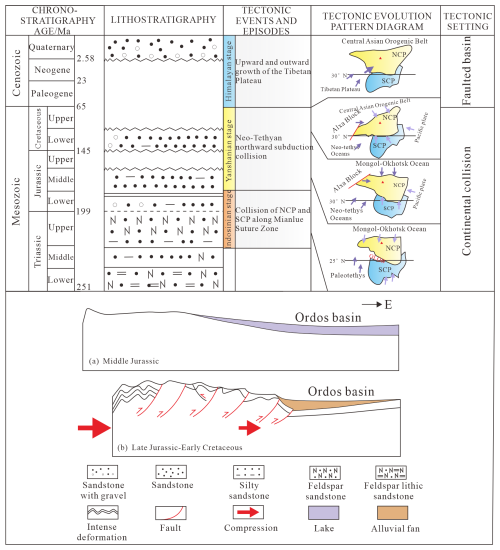
Figure 9Dynamic model diagram of the northern part of the western margin of the Ordos Basin. The direction and shading of the arrows represent the orientation and magnitude of the applied stress, respectively (modified from Zhang et al., 2021; Peng et al., 2022). QLOB – Qinling Orogenic Belt.
In the Late Jurassic, the Yanshanian orogeny triggered the first major large-scale exhumation in the study area. During this period, the compressional forces that were primarily north–south oriented during the earlier Indosinian orogeny transitioned to an east–west orientation characteristic of the Yanshanian phase (Dong et al., 2007, 2008, 2021; Zhang et al., 2008). This tectonic exhumation event aligns with the peak ages obtained from fission tracks at 170, 161, and 153 Ma. The tectonic evolution of this phase was controlled by several factors, notably the southwest Tethys tectonic domain, eastward compression from the Alxa Block, and the closure of the Okhotsk Ocean in the north during the Late Jurassic (Zhao et al., 2023). Additionally, far-field effects from the subduction of the Pacific Plate played a role (Darby and Ritts, 2002, 2007; Faure et al., 2012; Liu, 1998; Yang et al., 2008; Zhang et al., 2020, 2021, 2022; Zhao et al., 2023). Previous palaeomagnetic studies revealed that the Ordos Basin was undergoing an anticlockwise rotation during this period (Zhao and Coe 1987; Zhang et al., 2000). These regional tectonic processes collectively shaped the large-scale exhumation and deformation seen during this period, marking a significant phase in the geological history of the area. The comprehensive analysis of stress fields in the Late Jurassic indicates that multiple tectonic blocks around the Ordos Basin experienced subduction, collision, compression, and even mutual rotation. These interactions led to the folding and exhumation of Jurassic strata, accompanied by a series of imbricate thrust faults pushing from west to east (Zhao and Coe, 1987; Ma and He, 2019; Zhang et al., 2021, 2022). In the ZM region, the collision with the Alxa Block started significant exhumation, while in the MH region, the overall exhumation of the Qilian Mountains and its thrusting into the basin resulted in strong thrusting structures. This contributed to the earlier onset of exhumation in areas like the ZM region and MH region. The compressional deformation shows a general pattern of stronger exhumation and deformation in the west and at the margins, with weaker effects in the interior of the basin.
The Early Cretaceous was a crucial period in the evolution of the Ordos Basin; the deep thermal material in the basin began to upwell. Northern China was under an extensional tectonic regime, linked to the broader lithospheric thinning and basin development of the North China Craton during this time (Ren et al., 2007, 2008, 2014, 2017, 2020, 2022). In the central Taole region, extensional faults from this period are observable in seismic profiles (Zhao et al., 2007a). Towards the end of the Early Cretaceous, the regional tectonic stress field reversed due to the multiple phases of the Yanshanian orogeny (phases II, III, IV). The area was simultaneously influenced by the northward collision of the Yangtze Plate and the far-field effects of the Pacific Plate. The northern region was affected by the closure of the Okhotsk Ocean, and the western region continued to experience direct compression from the eastward movement of the Alxa Block (Yang et al., 2008; Zhang et al., 2020, 2022; Zhao et al., 2023). The previously deposited strata experienced intensified folding and exhumation under compressional stress. This led to the formation of large-scale south–north-oriented thrust faults and imbricate thrust structures. At this point, the tectonic landscape of the study area was basically formed.
During the Cenozoic, the tectonic deformation of the Ordos Basin was primarily driven by the collision between the Indian and Eurasian plates. This is the primary cause of the closure of the Tethys Ocean and one of the factors responsible for the stresses applied in the region, with significant tectonic activity occurring during the Eocene to Miocene. The continued Himalayan orogeny caused strong tectonic movements in the region, leading to further exhumation of the strata. The strata predominantly displayed parallel and angular unconformities. This tectonic activity has significantly shaped the present-day landscape. The neighbouring Alxa region, located at the northeastern edge of the Tibetan Plateau, was affected by the plateau's Cenozoic exhumation. Its deformation is closely linked to the evolution of the Tibetan Plateau (Zhang et al., 2023; Rao et al., 2016; Lei et al., 2022). Concurrently, the Pacific Plate continued its northwestward subduction during this period. Numerous geochronological records document the exhumation and northeastward expansion of the northeastern Tibetan Plateau during the Cenozoic, particularly in the Eocene and Miocene (England and Houseman, 1986; Wang et al., 2008; Lease et al., 2011, 2012; Craddock et al., 2011; Ding et al., 2022; Peng et al., 2019; Zhao et al., 2023; Zhang et al., 2020). Low-temperature thermochronology data, along with thermal-history reconstructions constrained by AHe and AFT, reveal rapid exhumation during the Eocene to Miocene, likely a result of the far-field effects of the Cenozoic exhumation of the northeastern Tibetan Plateau and the northwestward subduction of the Pacific Plate.
Overall, the study area has undergone the Indosinian, Yanshanian, and Himalayan orogenies since the Mesozoic era. In the central-northern section of the western margin of the basin, especially during the Yanshanian period, the Alxa rigid block sandwiched between the South China and North China plates is squeezed out in a southeast direction, directly affecting the Helanshan Mountains and the northern part of the western margin of the basin, causing the stress direction to shift towards a nearly east–west direction.
-
This study used apatite fission-track (AFT) and apatite (U–Th) He (AHe) dating methods, combined with thermal-history modelling, to precisely constrain the exhumation and cooling history of the central-northern sections of the western margin of the Ordos Basin. The analysis reveals significant differences in the timing and intensity of exhumation across different regions: the ZM region experienced large-scale exhumation during the Late Jurassic (160–150 Ma), slow exhumation in the Early Cretaceous–Oligocene (130–30 Ma), and severe exhumation after the Oligocene (30 Ma); the TH region exhumation began in the Late Jurassic–Early Cretaceous (155–145 Ma), underwent slow exhumation in the Early Cretaceous–Oligocene (145–30 Ma), and then underwent violent exhumation; the MH region experienced significant exhumation in the Late Jurassic–Early Cretaceous (158–137 Ma), with a slightly slower exhumation rate in 137–110 Ma, and entered a severe exhumation stage again in the Late Cretaceous–Eocene (70–50 Ma). Overall, the northern and southern sections began exhumation earlier, while the central section initiated exhumation slightly later. These findings highlight the spatial variation in exhumation timings and rates within the western Ordos Basin.
-
The study reveals that the Yanshanian orogeny had the most significant tectonic impact on the study area. Multiple exhumation events during the Mesozoic were responses to the multi-phase Yanshanian orogeny in this region. Since the Cenozoic, rapid exhumation influenced by the Himalayan orogeny has shaped the current landscape.
The data that support the findings of this study are available from the corresponding author upon reasonable request.
GX: writing (original draft), conceptualization, methodology, writing (review editing), software, resources, data curation, formal analysis. ZR: writing (original draft), conceptualization, methodology, investigation, resources, writing (review and editing), supervision, project administration, funding acquisition. KQ: writing (original draft), writing (review and editing). SG: investigation. YL: investigation. YZ: methodology. HL: methodology.
The contact author has declared that none of the authors has any competing interests.
Publisher's note: Copernicus Publications remains neutral with regard to jurisdictional claims made in the text, published maps, institutional affiliations, or any other geographical representation in this paper. While Copernicus Publications makes every effort to include appropriate place names, the final responsibility lies with the authors.
Our heartfelt gratitude is given to the anonymous reviewers for their scientific and linguistic revisions to the manuscript.
This research has been supported by the Major Projects of PetroChina Changqing Oilfield Company (grant no. ZDZX2021) and PetroChina Changqing Oilfield Company Science and Technology Major Projects “Research on Tectonic-Sedimentary Environment, Hydrocarbon Accumulation Conditions and Favorable Exploration Zones in the Deep Strata of Ordos Basin” (grant no. 2024D1JC06).
This paper was edited by Kei Ogata and reviewed by Martha Papadopoulou and two anonymous referees.
Bao, H. P., Shao, D. B., Hao, S. L., Zhang, G. S., Ruan, Z. Z., Liu, G., and Ouyang, Z. J.: Basement structure and early sedimentary cover evolution of the Ordos Basin, Earth Sci. Front., 26, 33–43, 2019.
Barbarand, J., Carter, A., Wood, I., and Hurford, T.: Compositional and structural control of fission-track annealing in apatite, Chem. Geol., 198, 107–137, 2003.
Carlson, W. D., Donelick, R. A., and Ketcham, R. A.: Variability of apatite fission-track annealing kinetics: I. Experimental results, Am. Mineral., 84, 1213–1223, 1999.
Chen, G.: Composition of Mesozoic terrigenous clastic rocks and their tectonic attributes in the Ordos Basin, Acta Sedimentol. Sin., 3, 409–413, 1999.
Chen, G., Wang, Z. W., Bai, G. J., Sun, J. B., Zhang, H. R., and Li, X. D.: Peak age events and their sedimentary-tectonic responses in the Mesozoic-Cenozoic Ordos Basin, Geol. China, 3, 375–383, 2007.
Craddock, W., Kirby, E., and Zhang, H. P.: Late Miocene-Pliocene range growth in the interior of the northeastern Tibetan Plateau, Lithosphere, 3, 420–438, 2011.
Darby, B. J. and Ritts, B. D.: Mesozoic contractional deformation in the middle of the Asian tectonic collage: the intraplate Western Ordos fold–thrust belt, China, Earth Planet. Sc. Lett., 205, 13–24, 2002.
Darby, B. J. and Ritts, B. D.: Mesozoic structural architecture of the Lang Shan, North-Central China: Intraplate contraction, extension, and synorogenic sedimentation, J. Struct. Geol., 29, 2006–2016, 2007.
Ding, L., Kapp, P., Cai, F., Garzione, C. N., Xiong, Z. Y., Wang, H. Q., and Wang, C.: Timing and mechanisms of Tibetan Plateau uplift, Nat. Rev. Earth Environ., 3, 652–667, 2022.
Dong, S. W., Zhang, Y. Q., Chen, X. H., Long, C. X., Wang, T., Yang, Z. Y., and Hu, J. M.: Formation and deformation characteristics of the Late Jurassic multidirectional convergent tectonic system in East Asia, Acta Geosci. Sin., 29, 306–317, 2008.
Dong, S. W., Zhang, Y. Q., Long, C. X., Yang, Z. Y., Ji, Q., Wang, T., Hu, J. M., and Chen, X. H.: New interpretations of the Jurassic tectonic transformations and the Yanshan Movement in China, Acta Geol. Sin., 81, 1449–1461, 2007.
Dong, Y. P., Li, W., Zhang, F. F., Sun, J. P., and He, D. F.: Formation and evolution of the Helan Mountain in the northern section of the North-South tectonic belt, Journal of Northwest University, Natural Science Edition, 51, 951–968, https://doi.org/10.16152/j.cnki.xdxbzr.2021-06-004, 2021.
England, P. and Houseman, G.: Finite strain calculations of continental deformation: comparison with the India-Asia collision zone, J. Geophys. Res.-Sol. Ea., 91, 3664–3676, 1986.
Farley, K. A., Wolf, R. A., and Silver, L. T.: The effects of long alpha-stopping distances on (U-Th) He ages, Geochim. Cosmochim. Ac., 60, 4223–4229, 1996.
Faure, M., Lin, W., and Chen, Y.: Is the Jurassic (Yanshanian) intraplate tectonics of North China due to westward indentation of the North China block?, Terra Nova, 24, 456–466, 2012.
Flowers, R. M., Farley, K. A., and Ketcham, R. A.: A reporting protocol for thermochronologic modeling illustrated with data from the Grand Canyon, Earth Planet. Sc. Lett., 432, 425–435, 2015.
Gallagher, K.: Transdimensional inverse thermal history modeling for quantitative thermochronology, J. Geophys. Res.-Sol. Ea., 117, B02401, https://doi.org/10.1029/2011JB008825, 2012.
Gan, K. W.: On the genesis mechanism of thrust belts and hydrocarbon prospects of the western margin of the Ordos Basin, in: Thrust Tectonics and Hydrocarbon in the Western Ordos Basin, edited by: Yang, J. J., Gansu Science and Technology Press, Lanzhou, 31239, ISBN: 9787542402776, 1990.
Gao, F., Wang, Y. J., Liu, S. S., and Hu, B. Q.: Study on the thermal history of the western margin of the Ordos Basin using apatite fission track analysis, Geotectonica et Metallogenia, 1, 87–91, 2000.
Gao, S. H.: Mesozoic-Cenozoic evolutionary modification of the lateral structural belt in the central western Ordos Basin and its significance for oil and gas, Northwest University, Xi'an, 2014.
Hasebe, N., Barbarand, J., Jarvis, K., Carter, A., and Hurford, A. J.: Apatite fission-track chronometry using laser ablation ICP-MS, Chem. Geol., 207, 135–145, 2004.
Jiang, S. Y., Huang, W. H., Zhang, Y. S., Xing, E. Y., Gui, B. L., Peng, Y., Zhao, H. T., and Shang, W. J.: Tectonic setting and provenance analysis of the sandstones from the Sandaokan Formation in the northern segment of the western Ordos Basin, Journal of Northeast Petroleum University, 43, 17–28, https://doi.org/10.3969/j.issn.2095-4107.2019.04.002, 2019.
Ketcham, R. A., Carter, A., Donelick, R. A., Barbarand, J., and Hurford, A. J.: Improved modeling of fission-track annealing in apatite, Am. Mineral., 92, 799–810, 2007.
Ketcham, R. A.: Forward and inverse modeling of low-temperature thermochronometry data, Rev. Mineral. Geochem., 58, 275–314, 2005.
Lease, R. O., Burbank, D. W., Hough, B., Wang, Z. C., and Yuan, D. Y.: Pulsed Miocene range growth in northeastern Tibet: insights from Xunhua Basin magnetostratigraphy and provenance, GSA Bull., 124, 657–677, 2012.
Lease, R. O., Burbank, D. W., Clark, M. K., Farley, K. A., Zheng, D. W., and Zhang, H. P.: Middle Miocene reorganization of deformation along the northeastern Tibetan Plateau, Geology, 39, 359–362, 2011.
Lei, Q. Y., Yu, J. X., Zhang, P. Z., Zheng, W. J., Zhang, Z. Q., Du, P., and Wang, Y.: Tectonic geomorphology and prehistoric earthquakes of the West Helanshan fault, West Ordos, and its implications for regional tectonics and seismic hazard, Tectonophysics, 833, 229375, https://doi.org/10.1016/j.tecto.2022.229375, 2022.
Li, B.: Tectonic characteristics and hydrocarbon accumulation studies of the foreland basin in the western Ordos Basin, Graduate School of Chinese Academy of Sciences, Guangzhou Institute of Geochemistry, 2006.
Li, B.: Study on the thrust belt structure and hydrocarbon controlling factors in the western Ordos Basin, Northwest University, China, 2019.
Li, T. B.: Characteristics and evolution of thrust structures in the western Ordos Basin, China University of Geosciences (Beijing), 2006.
Liu, C. Y., Zhao, H. G., Wang, F., and Chen, H.: Mesozoic tectonic characteristics of the western margin of the Ordos Basin, Acta Geol. Sin., 79, 737–747, 2005.
Liu, C. Y., Huang, L., Zhao, H. G., Wang, J. Q., Yang, L. H., Xi, X. D., and Peng, H.: Continental lateral transformation structures and their geological effects, Acta Geol. Sin., 98, 3455–3477, 2024.
Liu, H. F.: Types of foreland basins and styles of fold-thrust structures, Earth Sci. Front., 2, 59–68, 1995.
Liu, J. H.: Cenozoic extensional uplift of the Helan Mountains and Qinling Mountains and analysis of fault frictional heating using apatite fission track method, Int. Seismol. Dynam., 3, 31–33, 2010.
Liu, S. F.: The coupling mechanism of basin and orogen in the western Ordos Basin and adjacent regions of China, J. Asian Earth Sci., 16, 369–383, 1998.
Liu, S. F. and Yang, S. G.: North-south differences and their formation mechanism on the western margin of the Ordos Basin, Geol. Sci., 32, 397–408, 1997.
Ma, J. H. and He, D. F.: Mesozoic-Cenozoic tectonic events in the Helan Mountain tectonic belt and adjacent areas: constraints from unconformities and fission track analysis, Acta Petrol. Sin., 35, 1121–1142, 2019.
Ouyang, Z. J., Chen, H. D., and Feng, J. P.: Tectonic characteristics and evolution of the central and southern segments of the western margin of the Ordos Basin, Modern Geol., 26, 691–695, 2012.
Peng, H.: Fission track thermochronology analysis and its geological significance in the southwestern adjacent area of the Ordos Block, Northwest University, Xi'an, China, 2020.
Peng, H., Wang, J. Q., Liu, C. Y., Zhang, S. H., Zattin, M., Wu, N., and Feng, Q.: Thermochronological constraints on the Meso-Cenozoic tectonic evolution of the Haiyuan-Liupanshan region, northeastern Tibetan Plateau, J. Asian Earth Sci., 183, 103966, 2019.
Peng, H., Wang, J. Q., Liu, C. Y., Huang, L., and Zattin, M.: Mesozoic exhumation and ca. 10 Ma reactivation of the southern Yin Shan, North China, revealed by low-temperature thermochronology, Tectonophysics, 823, 229189, 2022.
Peng, H., Ding, L., Liu, C. Y., Zattin, M., and Wang, L. C.: Middle Triassic transcontinental connection between the North China Craton and the Paleo-Tethys Ocean, Commun. Earth Environ., 5, 775, https://doi.org/10.1038/s43247-024-01945-z, 2024.
Rao, G., Chen, P., Hu, J. M., Yu, Y. L., and Qiu, J. H.: Timing of Holocene paleo-earthquakes along the Langshan Piedmont Fault in the western Hetao Graben, North China: implications for seismic risk, Tectonophysics, 677, 115–124, 2016.
Ren, Z. L.: Study on the geothermal history of the Ordos Basin using the apatite fission track method, Chin. J. Geophys., 38, 339–349, 1995.
Ren, Z. L., Zhang, S., Gao, S. L., Cui, J. P., Xiao, Y. Y., and Xiao, H.: Tectonic thermal evolution history of the Ordos Basin and its significance for accumulation and mineralization, Sci. China Ser. D, S1, 23–32, 2007.
Ren, Z. L., Liu, L., Cui, J. P., Xiao, H., and Gao, S. L.: Application of tectonic thermal evolution history in the study of hydrocarbon accumulation phases, Oil Gas Geol., 29, 502–506, 2008.
Ren, Z. L., Tian, T., Li, J. B., Wang, J. P., Cui, J. P., Li, H., Tang, J. Y., and Guo, K.: Research methods for thermal evolution history of sedimentary basins and progress in reconstructing thermal evolution history of overlapping basins, J. Earth Sci. Environ., 36, 1–20, 2014.
Ren, Z. L., Yu, Q., Cui, J. P., Qi, K., Chen, Z. J., Cao, Z. P., and Yang, P.: Thermal evolution history of the Ordos Basin and its control on hydrocarbons, Earth Sci. Front., 24, 137–148, 2017.
Ren, Z. L., Qi, K., Liu, R. C., Cui, J. P., Chen, Z. P., Zhang, Y. Y., Yang, G. L., and Ma, Q.: The dynamical background of Early Cretaceous tectonic thermal events in the Ordos Basin and their control on the accumulation periods of various minerals, including oil and gas, Acta Petrol. Sin., 36, 1213–1234, 2020.
Ren, Z. L., Cui, J. P., Qi, K., Yang, P., Liu, X. S., Zhang, C. L., Yang, G. L., Gao, Y. F., Zhang, Y., and Xing, G. Y.: New advances in the theoretical research and methods for restoring the thermal evolution history of deep and ultra-deep layers in overlapping basins, Journal of Northwest University, Natural Science Edition, 52, 910–929, https://doi.org/10.16152/j.cnki.xdxbzr.2022-06-002, 2022.
Tang, X. Y.: Thrust nappe structures and hydrocarbon exploration on the western margin of the Shaanxi-Gansu-Ningxia Basin [M], Northwest University Press, Xi'an, China, ISBN: 7-5604-0392-1, 1992.
Tang, X. Y., Guo, Z. M., and Wang, D. Y.: Characteristics, evolution, and hydrocarbon exploration of the thrust nappe structure belt in the western Ordos Basin, Oil Gas Geol., 9, 1–10, 1988.
Tian, C. Y., Chen, H., Liu, X. S., Gong, W. B., Zhao, W. B., and Kang, R.: Fission track ages and Mesozoic tectonic uplift in the Niushou Mountain-Luoshan area of the western Ordos, J. Geol. Mech., 29, 599–617, 2023.
Vermeesch, P.: RadialPlotter: a Java application for fission track, luminescence and other radial plots, Radiat. Meas., 44, 409–410, 2009.
Wang, C. S., Zhao, X. X., Liu, Z. F., Lippert, P. C., Graham, S. A., Coe, R. S., Yi, H. S., Zhu, L. D., Liu, S., and Li, Y. L.: Constraints on the early uplift history of the Tibetan Plateau, P. Natl. Acad. Sci. USA, 105, 4987–4992, 2008.
Wang, W., Zhao, Y., Liu, X. C., Hu, J. M., Wei, C. J., Xiao, W. J., Du, J. X., Wang, S. L., and Zhan, L. Q.: Metamorphism of diverse basement gneisses of the Ordos Basin: record of multistage Paleoproterozoic orogenesis and constraints on the evolution of the western North China Craton, Precambrian Res., 328, 48–63, 2019.
Xing, G. Y., Ren, Z. L., Qi, K., Guo, S. S., and Liu, Y. Z.: Low-temperature thermochronologic analysis and geologic significance of the northern part of the western margin of the Ordos Basin: a case study of the Moergou profile in the Zhuozishan area, Inner Mongolia, China, Geol. J., 60, 871–882, https://doi.org/10.1002/gj.5108, 2024.
Yang, H., Fu, J. H., Ouyang, Z. J., and Sun, L. Y.: Analysis of tectonic-sedimentary environments during the Late Triassic in the western margin of the Ordos Basin, Acta Sedimentol. Sin., 29, 427–439, 2011.
Yang, J. J. and Zhang, B. R.: Strike-slip rift and associated thrust belt: a case study of the Yinchuan Graben and Hengshanpu Thrust Belt, Petrol. Explor. Dev., 2, 1–8, 1986.
Yang, S. B., Guo, Q. Y., Hou, G. T., and Sun, H.: Subsidence history and sedimentary response in the northern segment of the western Ordos Basin, Journal of Peking University, Natural Science Edition, 42, 192–198, 2006.
Yang, S. B., Geng, X. X., Guo, Q. Y., Hou, G. T., and Liu, Z. B.: Mesozoic tectonic evolution of the northern segment of the western Ordos Basin, Geol. Rev., 54, 307–315, 2008.
Zhai, M. G.: The formation, evolution, and metallogenesis of the North China Craton, Mineral Deposits, 1, 24–36, 2010.
Zhai, M. G.: The Ordos Block: the key to unraveling the mysteries of early continental formation, evolution, and tectonic regime of the North China Craton, Chinese Sci. Bull., 66, 3441–3461, 2021.
Zhang, C. L., Gou, L. L., Diwu, C. R., Liu, X. Y., Zhao, J., and Hu, Y. H.: Precambrian geological events, nature, and geological significance of the basement in the western North China Craton, Acta Petrol. Sin., 34, 981–998, 2018.
Zhang, G. W., Dong, Y. P., and Yao, A. P.: A new starting point for the study of orogenic belts and orogenesis, Northwest Geol., 34, 1–9, 2001.
Zhang, J., Ma, J. Z., and Ren, W. J.: Mechanism of north-south differences in the overthrust belt on the western margin of the Ordos Basin, Geotectonica et Metallogenia, 2, 124–133, 2000.
Zhang, J., Yun, L., Zhang, B. H., Qu, J. F., Zhao, H., Hui, J., Wang, Y. N., and Zhang, Y. P.: Deformation at the easternmost Altyn Tagh Fault: constraints on the growth of the northern Qinghai-Tibetan plateau, Acta Geol. Sin., 94, 988–1006, 2020.
Zhang, J., Wang, Y. N., Qu, J. F., Zhang, B. H., Zhao, H., and Yun, L.: Mesozoic intracontinental deformation of the Alxa Block in the middle part of Central Asian Orogenic Belt: a review, Int. Geol. Rev., 63, 1490–1520, 2021.
Zhang, J., Cunningham, D., Qu, J. F., Zhang, B. H., Li, J. Y., Zhao, H., Niu, P. F., Hui, J., Yun, L., Zhao, S., Zheng, R. G., and Zhang, Y. P.: Poly-phase structural evolution of the northeastern Alxa Block, China: constraining the Paleozoic-Recent history of the southern central Asian Orogenic belt, Gondwana Res., 105, 25–50, 2022.
Zhang, J., Zhang, B. H., Zhao, H., Yun, L., Qu, J. F., Wang, Z. Y., Yang, Y. Q., and Zhao, S.: Characteristics and mechanisms of Late Cenozoic deformation in the Beishan-Alashan region, Earth Sci. Front., 30, 334, https://doi.org/10.13745/j.esf.sf.2023.8.16, 2023.
Zhang, J. S., He, Z. X., Fei, A. Q., Li, T. B., and Huang, X. N.: Large margin thrust nappe system in the northern segment of the western Ordos Basin, Geol. Sci., 43, 251–281, 2008.
Zhao, H. G.: Tectonic characteristics and evolution of the western Ordos Basin, Northwest University, China, 2003.
Zhao, H. G., Liu, C. Y., Wang, F., and Wang, J. Q.: Tectonic partitioning and characteristics of the western margin of the Ordos Basin, Oil Gas Geol., 27, 173–179, 2006.
Zhao, H. G., Liu, C. Y., Wang, F., Wang, J. Q., Li, Q., and Yao, Y. M.: Uplift timing and evolution of the Helan Mountains, Sci. China Ser. D, 37, 185–192, 2007a.
Zhao, H. G., Liu, C. Y., Wang, J. Q., Wang, F., and Yin, Y.: Exploration of tectonic attributes during the Late Triassic in the western Ordos Basin, Geol. J. China, 34, 384–391, 2007b.
Zhao, H. G., Liu, C. Y., Yao, Y. M., Wang, F., and Yin, Y.: Fission track evidence of differential uplift in the western Ordos Basin, Journal of Northwest University, Natural Science Edition, 3, 470–474, https://doi.org/10.16152/j.cnki.xdxbzr.2007.03.029, 2007c.
Zhao, P., Xu, B., and Chen, Y.: Mongolian-Okhotsk Ocean: evolutionary process and final closure, Sci. China Earth Sci., 53, 2541–2559, 2023.
Zhao, X. and Coe, R. S.: Palaeomagnetic constraints on the collision and rotation of North and South China, Nature, 327, 41–44, 1987.
Zhao, X. C.: Mesozoic tectonic evolution and later modification of the northern section of the North-South tectonic belt in China, Northwest University, Xi'an, China, 2017.
Zhao, Z. Y., Liu, C. Y., and Ren, Z. L.: Geology of oil and gas basins and system engineering in their research, Oil Gas Geol., 11, 108–113, 1990.
Zhuo, Y. Z.: Determination of Mesozoic-Cenozoic uplift events in the Zhuozishan area of the northwestern Ordos Basin and their tectonic significance, Northwest University, China, 2015.





